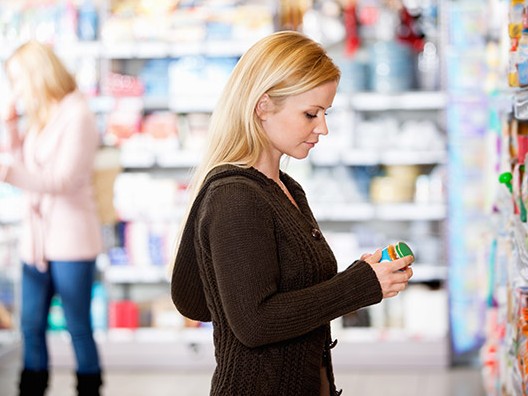
‘Manufacturers are making a mockery of labelling rules’ was the headline of a recent press release by the Dutch Consumers’ Association. The Association had examined various products on sale in supermarkets and found the claims to be misleading. Where do the discrepancies lie, according to the Association? And are they illegal?
Food producers are unjustifiably making products appear better or healthier than similar products, such as by labelling their gingerbread with the words ‘source of fibre’ even though all regular gingerbread is a natural source of fibre. Manufacturers are also leading consumers to believe that their unhealthy products are actually healthy ones: claims such as ‘including B vitamins’ can often be found on confectionery packaging, or ‘source of fibre’ on packets of crisps and salted nibbles. That’s taking things a little far.
Food packaging and labels are subject to various rules, which are laid down in a number of different European and national laws. The same legislation does not apply in every European country, and the national supervisory boards do not apply the laws in the same way everywhere. That presents a huge challenge for internationally active food manufacturers. This article provides a brief overview of a number of key legal frameworks in The Netherlands.
It is illegal to provide misleading (sales) information 1. The product packaging is a way of providing information and hence falls within the scope of this law. Misleading claims can apply to the primary characteristics of a product such as its benefits, composition or the results that can be expected following the use or consumption of it.
Is it permissible for the asparagus in a product labelled ‘Limburg asparagus soup’ to come from France? 2 And may egg salad be called ‘free-range egg salad’ if the mayonnaise in the salad is made from eggs laid by battery hens? 3 When assessing whether information is misleading, the decision revolves around a fictitious ‘average consumer’, i.e. it is not about ‘every’ consumer. Furthermore, in order to be construed as misleading, that information must have triggered the ‘average consumer’ to purchase the product. It is expected that the average consumer will also read the ingredient declaration on the back of the packaging. In other words, there is considerable leeway before a claim is truly misleading. The Dutch Authority for Consumers and Markets (ACM) monitors compliance with the general rules relating to misleading claims. Consumers can also take their case to the civil courts or can lodge a complaint with the Dutch Advertising Code Committee 4. The Netherlands Food and Consumer Product Safety Authority (NVWA) does not immediately act on complaints about misleading claims which do not pose a risk to public health. If over time it becomes apparent that many complaints concern the same topic the NVWA can decide to launch an investigation.
Separate rules apply to the labelling of food products 5. These requirements are intended to provide consumers with clear and honest information about product composition. The rules apply mainly to providing correct information about allergens, nutritional values and ingredients and to naming any additives used. Other aspects are the origin of the product, the shelf life and the storage and preparation methods, the product name and indication of the manufacturer/importer. NVWA monitors compliance with specific rules. It is also possible to lodge a complaint with the Dutch Advertising Code Committee 6. Incidentally, the study by the Dutch Consumers’ Association did not check compliance with labelling requirements, so the press release’s headline ‘Manufacturers are making a mockery of labelling rules’ was itself a little misleading.
Manufacturers sometimes prominently promote certain product characteristics on the packaging, such as ‘no added sugars’ or ‘good for bones’. Such claims must comply with other rules 7, which are also aimed at preventing consumers from being misled. A distinction is made between two sorts of claims: ‘nutrition claims’ and ‘health claims’.
Nutrition claims are claims about the nutritional properties of a product, whereas health claims are about the characteristics of a product (or one of its ingredients) which have a beneficial effect on human health 8. Both sorts of claims must be:
- Possible to substantiate scientifically
- Easy to understand and not misleading for consumers
The law only permits the use of 30 specifically mentioned nutrition claims. Moreover, those claims may only be used when the food product meets the relevant strict criteria. In the case of the claim ‘source of fibre’, for example, the product’s fibre content must be at least 3 grams/100 grams or 1.5 grams/100 kcal. If the product complies with this, the claim is valid.
Health claims
Health claims may only be displayed on the packaging when the claim has been approved by the European Food Safety Authority (EFSA), which involves completing a stringent procedure. To date, many thousands of claims have been submitted, of which only 256 have received approval 9. For example, the claim relating to flavanols in chocolate, namely that ‘daily consumption of 200mg of flavanols helps maintain the elasticity of blood vessels which contributes to normal blood flow’, was approved. Claims about probiotics in relation to intestinal flora have been rejected by EFSA. Non-specific claims which are linked to health may only be made in connection with a related, approved health claim. An example of this is the use of the word ‘resistance’ on a food supplement. This is permissible if it is adjacent to or followed by a specific, approved health claim which meets all the requirements, such as ‘vitamin C contributes to maintaining the normal function of the immune system’. But what about the use of claims such as ‘healthy’ or ‘superfood’? They could perhaps also qualify as a general health claim. NVWA ensures compliance with the claims legislation. It is also possible for consumers to lodge a complaint with the Dutch Advertising Code Committee 10 or, depending on the circumstances, to start civil proceedings.

The Dutch Consumers’ Association has submitted the results of its study to NVWA although it is unclear what NVWA will do with the information. This summer, NVWA published the findings of research into the packaging of breakfast products. Of the 126 packaging samples assessed from 24 different manufacturers, 64 did not comply with the legal requirements. The last time compliance with claim legislation was enforced on a wide scale was in late 2010. In August this year, Foodwatch launched the Meldpunt Misleiding (‘Hotline for Misleading Claims’) where consumers can lodge their complaints about misleading advertising for food products.
Companies in the industry – within their marketing and legal departments alike – should be aware of the large number and wide variety of rules that exist to prevent consumers from being misled. In practice, it can be difficult to navigate through the maze of rules and regulations, especially when a product is to be marketed in multiple countries. To claim or not to claim; that’s the question!
Footnotes
Source: Foto vrouw: ©Image licensed by SignBiblio